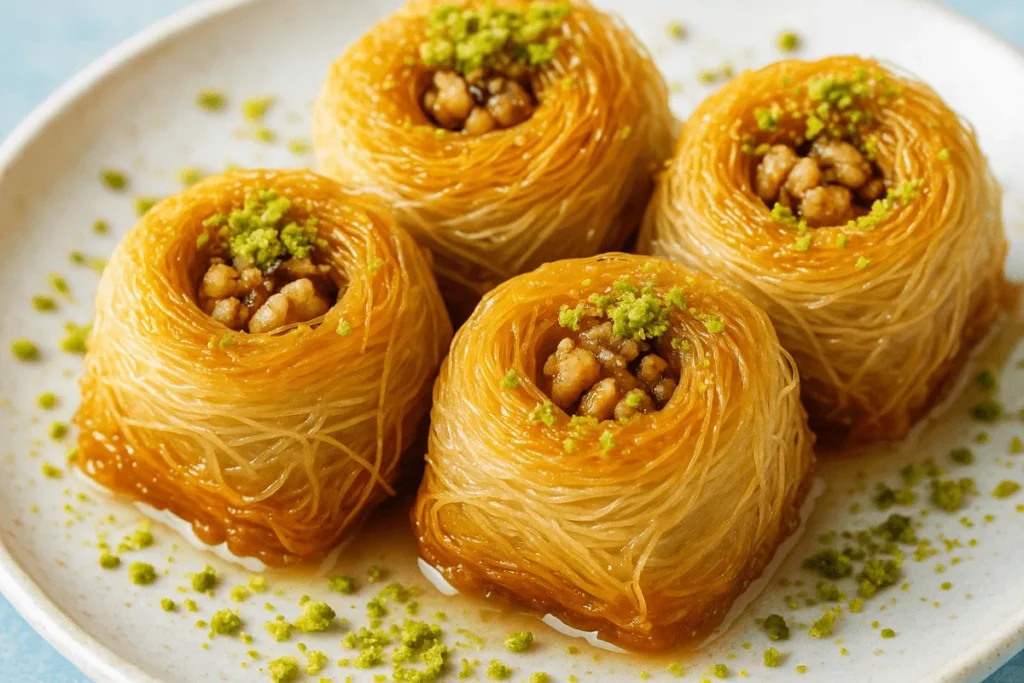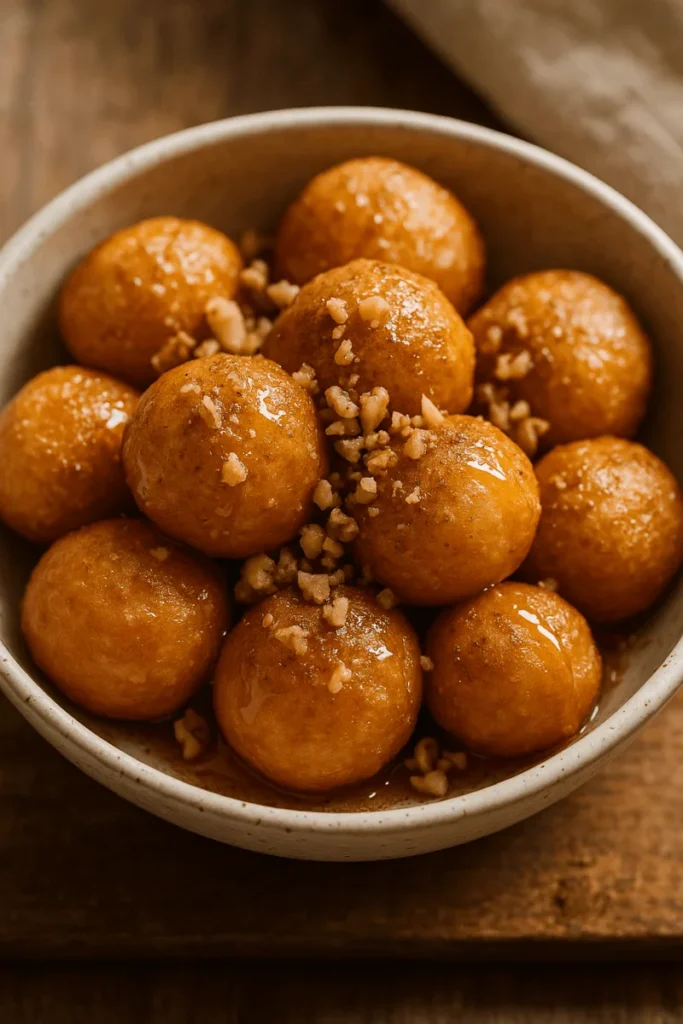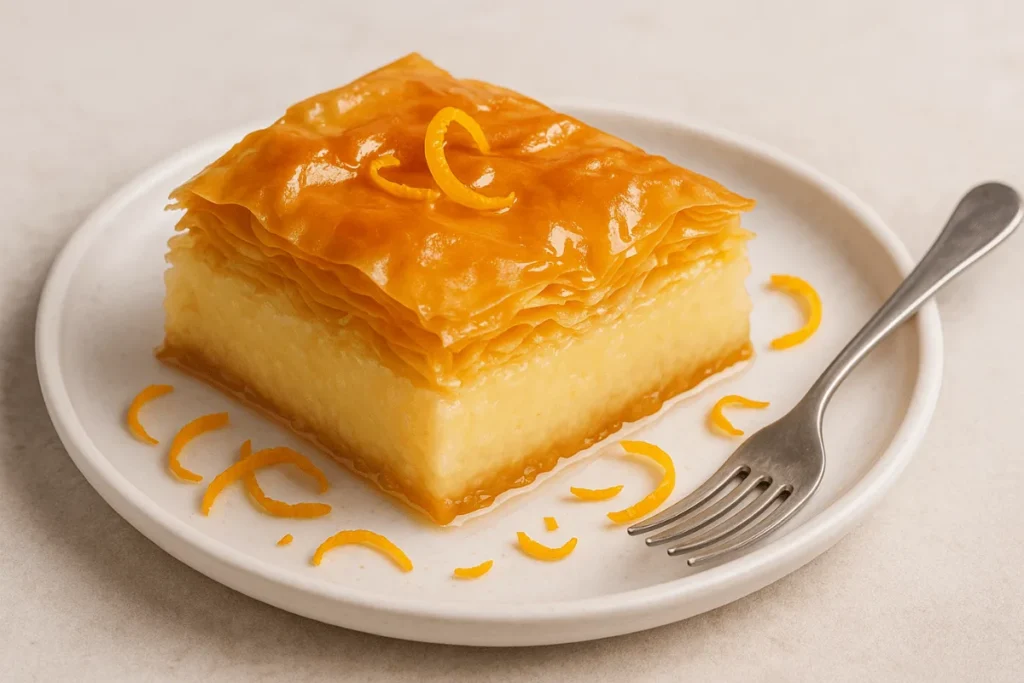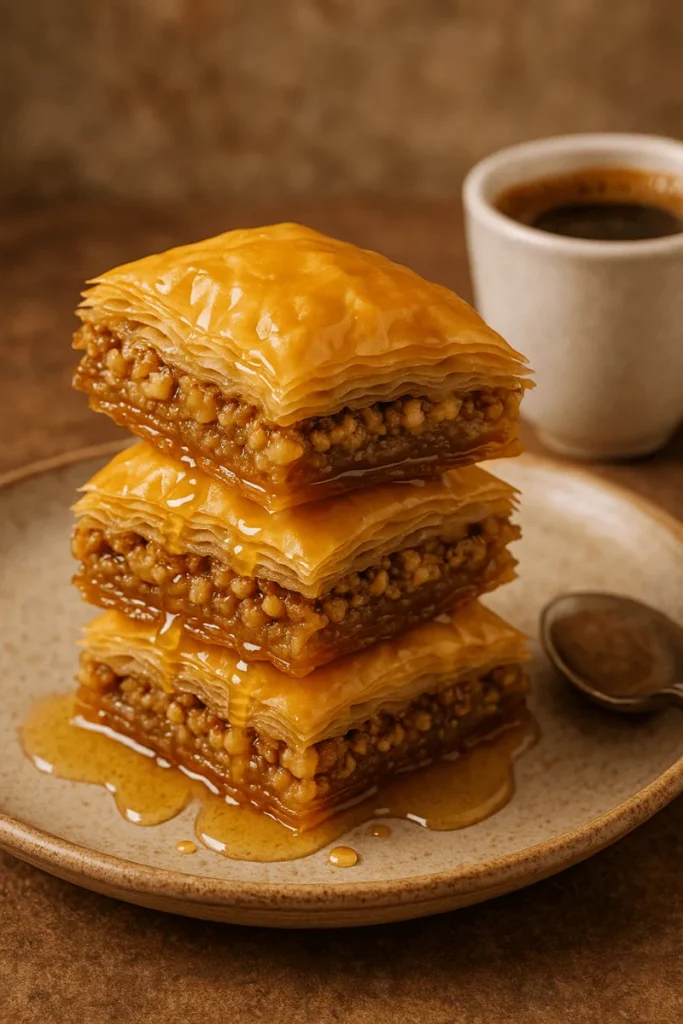Let’s focus on the most delightful part of any meal: Greek Desserts. The art of dessert-making has been truly mastered by the Greeks. We’re not just talking about a scoop of ice cream here; we’re talking about honey-soaked, nutty, flaky masterpieces that feel like a hug for your soul.
You might think you need a plane ticket to Athens to try these, but guess what? This magic can be crafted right in your kitchen. Let’s delve into four of my favorite picks.
Table of Contents
Kataifi: The Shredded Pastry Delight
It might just be the strangest-looking dessert you’ll ever make—like, it seriously looks like someone ran phyllo dough through a paper shredder. But trust me, that “edible bird’s nest” feel is exactly what makes it awesome.
You take this shredded phyllo, stuff it with nuts, roll it up, and drown it in honey syrup. The name comes from the Turkish word kadayıf, which makes sense since Greek and Turkish desserts are cousins.
What makes it so good is the texture—crispy, golden strands on the outside and soft, nutty goodness on the inside. It’s crunchy, it’s sweet, and it’s one of those desserts that feels fancier than the effort it takes.

What You’ll Need
Don’t worry, the ingredient list isn’t scary at all:
For the pastry:
- 1 lb kataifi pastry (Greek market or online find)
- ½ cup melted butter (be generous!)
- ¼ cup olive oil
For the nut filling:
- 2 cups of a nut mix (including walnuts, pistachios, almonds, or your choice)
- ¼ cup sugar
- 1 tsp cinnamon
- ½ tsp vanilla
- Zest of 1 orange (the secret flavor bomb)
For the syrup:
- 1½ cups sugar
- 1 cup water
- ½ cup honey
- 1 cinnamon stick
- 3 cloves
- Juice of half a lemon
How to Make This Thing
Step 1: Prep the nuts
Chop your nuts (not too fine—you want crunch!) and mix with sugar, cinnamon, vanilla, and orange zest.
Step 2: Deal with the pastry
Fluff up that shredded dough with your hands—kind of like giving it a spa day. Take a handful, make a little nest, add 2 tablespoons of nut mix, and wrap it up like the world’s tiniest burrito.
Step 3: Bake
Preheat your oven to 350°F. Butter a baking dish, line up your kataifi rolls, brush generously with the butter-oil mix, and bake for 25–30 minutes until golden brown (aka crunchy little hedgehogs).
Step 4: Syrup time
While baking, simmer all the syrup ingredients for 10 minutes. Add lemon juice at the end. As soon as the kataifi comes out of the oven, pour the hot syrup over it and listen to that glorious sizzle.
My Hot Tips for Success
Patience is everything! Let them cool completely so they soak up all the syrup. And honestly, don’t worry if they look a little messy—kataifi always tastes amazing no matter what.
Loukoumades: Golden Honey Puffs
Loukoumades are the OG Greek dessert. Ancient Olympians used to get these honey puffs as prizes—imagine winning donuts instead of medals. I’d compete every time.
They’re kind of like donut holes but lighter, crispier, and dripping with honey and cinnamon. Super simple, super addictive, and honestly, once you try them fresh, you’ll never look at donuts the same way again.

What You Need for These Little Golden Bombs
For the dough:
- 2 cups flour
- 1 packet active dry yeast
- 1 tsp sugar
- 1 tsp salt
- 1¼ cups warm water
- 2 tbsp olive oil
For topping:
- Greek honey (or any good honey)
- Cinnamon
- Chopped walnuts (optional, but fancy)
- Oil for frying
Making Loukoumades That’ll Ruin You for All Other Desserts
Step 1: The dough
Mix the yeast with sugar and warm water to bring it to life. In another bowl, mix the flour and salt, then add in the yeast mixture along with olive oil. Stir—it should look like thick pancake batter.
Step 2: Rise & shine
Let the bowl sit covered in a warm spot for 1–2 hours until it becomes bubbly and its size doubles.
Step 3: Frying fun
Heat oil to 350°F. For ease, use a pair of spoons to place dollops of dough into the oil. They’ll puff up and turn golden in about 3–4 minutes.
Step 4: Honey magic
Arrange them in a pile, coat with honey, sprinkle cinnamon over them, and add walnuts if you want to make it more luxurious.
from a Serial Loukoumades Eater
Oil temperature is key. Too hot = burnt outsides, raw insides. Too cold = greasy sadness. And eat them right away—loukoumades are not a “save for later” dessert.
Galaktoboureko: The Custard Dream
This dessert is next-level fancy. The name means “milk pastry,” but that doesn’t even scratch the surface. Envision a silky custard nestled within crisp phyllo, glazed with an orange-scented syrup.
It’s like if crème brûlée and baklava had a love child—and that child was raised by Greek grandmas who know all the secrets.

What Goes Into This Masterpiece
For the custard:
- 4 cups whole milk
- ½ cup semolina
- ½ cup sugar
- 4 eggs
- 1 tsp vanilla
- 2 tbsp butter
For assembly:
- 1 lb phyllo dough
- ½ cup melted butter
For the syrup:
- 1½ cups sugar
- 1 cup water
- ¼ cup honey
- 1 cinnamon stick
- Zest and juice of 1 orange
- 2 cloves
How to Make Galaktoboureko Without Losing Your Mind
Custard time
Heat the milk, then slowly whisk it into the eggs, sugar, and semolina (slowly, or you’ll get scrambled eggs). Cook until thick like pudding. Add vanilla and butter, cover with plastic wrap to avoid the dreaded custard skin.
Phyllo layering
Apply butter to your pan, arrange half of the phyllo sheets (buttering each layer), pour in the custard mixture, and finish with the remaining sheets on top. Score lightly before baking—it helps later.
Bake & syrup
Bake at 350°F for 45–50 minutes until golden. While that’s happening, simmer the syrup ingredients. After baking, add the cold syrup to the warm pastry and savor the sizzling effect.
The Secret to Galaktoboureko Success
Let it sit overnight. I know, torture. But trust me, the flavors get cozier, and the texture becomes perfect. Worth the wait.
Baklava: The Classic Nut & Honey Pastry
Baklava is the superstar of Greek desserts. Layers of buttery phyllo, spiced nuts, and honey syrup—it’s rich, sweet, and guaranteed to impress at any party.
Greek-style baklava is nutty and fragrant, and honestly, there’s no wrong way to eat it. Upside down? Sideways? Straight from the tray at midnight? All valid.

What You Need
For the nut filling:
- 3 cups walnuts
- 1 cup almonds
- ½ cup sugar
- 2 tsp cinnamon
- ¼ tsp cloves
- ¼ tsp salt
For the layers:
- 1 lb phyllo dough
- 1 cup melted butter
- 2 tbsp olive oil (optional but tasty)
For the syrup:
- 1½ cups sugar
- 1 cup water
- ½ cup honey
- 1 cinnamon stick
- 3 cloves
- Strip of lemon peel
- 1 tbsp lemon juice
Building Your Baklava Empire
Layer phyllo sheets with butter, sprinkle in nut mixture, repeat until you’ve got a towering pastry castle. Score into diamonds before baking—both pretty and practical. Bake at 325°F for 45–60 minutes.
Meanwhile, simmer your syrup. After taking the baklava out of the oven, pour syrup on top and let it soak. That sizzling sound? Pure happiness.
Baklava Wisdom from Years of Trial and Error
The hardest part isn’t making it—it’s waiting. Don’t cut it too soon, or it’ll collapse into sweet chaos (still tasty, though). Let it rest overnight for ultimate perfection.
Sweet Endings in Greek Style
And there you have it—four Greek desserts that prove the Greeks nailed the art of sweets. From the crispy strands of kataifi to the sumptuous indulgence of galaktoboureko, the golden spheres of loukoumades, and, undeniably, the famous baklava—each dessert is a hidden gem of joy.
Sure, a trip to Athens to taste the real deal would be dreamy, but honestly, you don’t need a passport for these flavors. With a bit of patience (and way more honey than you think), you can make them right at home. Just one warning: don’t count on leftovers. As soon as these are served, they disappear quicker than you can shout ‘opa!’
FAQ
What’s the most popular dessert in Greece?
Depends on who you ask, but Baklava and Galaktoboureko are basically everywhere. Loukoumades are also a superstar—there are entire shops just dedicated to these little honey puffs.
Is cheesecake Greek?
Not in the New York cheesecake way, but yes, Greece has cheesy desserts! “Melopita” is kind of like a honey-and-cinnamon cheesecake, and “Lihnarakia” from Crete are little pastries filled with creamy mizithra cheese. So, it’s cheesecake-ish.
What dessert goes well with gyros?
If you’re stuffed but still want something sweet, Greek yogurt with honey and nuts is a light, refreshing win. If you’re feeling extra indulgent, sneak in a Loukoumades or a piece of Baklava—you’ve earned it.
Are these desserts healthy?
They’re treats! They’ve got good stuff like nuts and honey, but they’re also all about indulgence. So enjoy them in moderation. A little sweetness is essential because life is too short!

